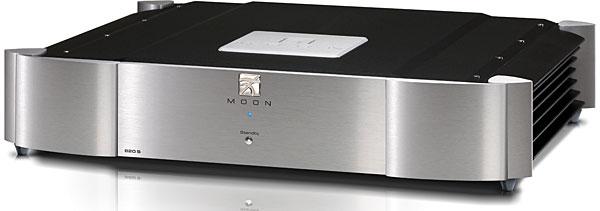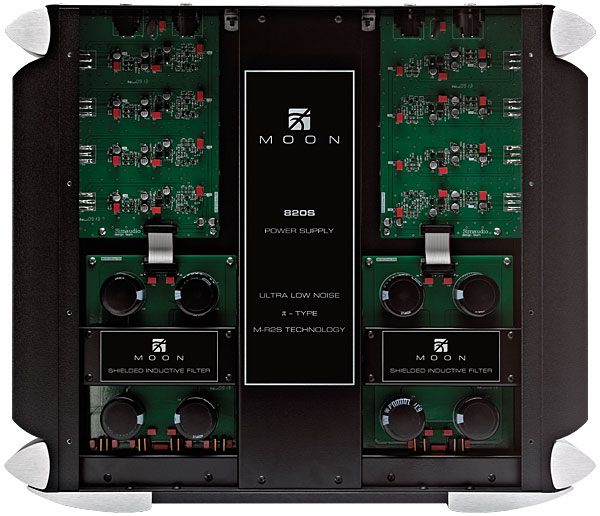| Columns Retired Columns & Blogs |
On each side of the power supply, are the dual Pi Filters connected in series or parallel to each other ?

What costs so much?
The Moon Evolution 820S's sculpted case is large (18.75" W by 4" H by 16.81" D), heavy (40 lbs), and nearly identical to the 650D's. Inside, to left and right, are two identical circuit boards separated by a large enclosure containing a pair of custom, proprietary toroidal transformers said to have low magnetic, electrical, and thermal loss that's claimed to result in improved power transfer and lower regulation factor, whatever that second term means. Simaudio says that all of this results in faster current flow and improved dynamic performance.
Though the two boards are identical, each is not reserved to power one of the two Moon Evolution components the 820S can drive. Rather, one board powers analog circuits, the other digital. In other words, when used in the 650D and 750D DAC-transports, one board provides the supply for the transport mechanism, front-panel display, software control circuitry, and digital audio circuitry; the other board is reserved exclusively for the analog signal, after it has been converted from digital.

The 820S's analog and digital supplies each have one special "pi" filter—at its simplest, a capacitor across the rectifier output, an inductor in series, and another capacitor across the load—to greatly reduce the transmission of noise in the AC power supply. The 820S has four capacitors totaling 40,000µF of capacitance and dual-choke 40mH (2x20mH) of inductance.
Each supply includes four stages of Simaudio's Moon Reference Regulation System (M-R2S), a fully discrete voltage-regulation circuit that uses a "precision reference," temperature-insensitive Texas Instruments NSI LM329 zener-diode chip to feed a discrete transistor-based hybrid amplification circuit (as opposed to the more commonly used single voltage-regulation chip). The M-R2S outputs pure DC power that Simaudio claims is exceptionally fast, precise, and stable, with a level of noise that is "virtually unmeasurable."
The 820S uses four-layer printed circuit boards with pure copper traces with extremely low impedance characteristics and short, low-noise signal paths, as well as the "finest quality," accurately matched electronic components used in a symmetrical circuit design.
Simaudio's one-sheet for the 820S claims that it brings the $9500 740P preamp's performance closer to that of the more expensive 850P ($30,000) in terms of transparency, neutrality, imaging, and noise, while adding the 820S to the $7500 610LP brings the latter's noise level, and thus the "blackness" of its backgrounds, closer to that of the more expensive 810LP ($13,000). Simaudio claims that adding the 820S to the 810LP itself produces even blacker backgrounds and more precise soundstaging and imaging—but I get the sense that, for an $8000 bump, the improvement is relatively small.

In my review of the 650D, I said that "the 650D has 18 stages of independent, inductive, DC power-supply voltage regulation (Simaudio calls this i2DCf) vs the 750D's 24 stages." In other words, adding the 820S to the 650D should bring its sound closer to that of the more expensive 750D. Interestingly, after that review was published, I heard from some readers and Simaudio fans who said that they preferred the 650D's sound to the 750D's, which in comparison they found too analytical and "clinical." Would adding an 820S improve or worsen the 650D's sound?
Easy installation
The 820S upgrade path was obviously planned during the design of the other products mentioned—in my case, that of the 650D. Each has both analog and digital multi-pin power-supply inputs. The 820S comes with two pairs of umbilical cables, only one of which was needed: I removed the power cord from the 650D and plugged it into the 820S. I then pressed the 820S's power switch—a blue LED came on—and powered up the 650D as usual. The 820S is designed to be left on at all times.
iPad in hand . . .
Once the Moon Evolution 820S was installed, I began my informal listening and drew some conclusions. After almost two months of listening that way, I browsed my collection using the Meridian Music Server's iPad app and spent a few evenings listening to individual tracks in a playlist. Once I'd heard a few dozen selections, it was time to shut it all down, return the 650D to self-powered operation, and listen to the same tracks again. A comparison like this is far more easily done in the digital domain, especially with a music server.
Among the things I listened to first were 16-bit/44.1kHz and hi-rez versions of the same tracks, downloaded from HDtracks. The hi-rez versions of Steely Dan's Gaucho (24/96 download vs gold SACD/CD, MCA/Mobile Fidelity Sound Lab), James Brown's 20 All Time Greatest Hits! (24/192 vs Polydor CD), and Béla Fleck, V.M. Bhatt, and Jie-Bing Chen's Tabula Rasa (24/88.2 vs CD, Water Lily Acoustics WLA-CS-44-CD) sounded obviously better.

Here in good ole Blighty, Hokey Pokey is the name for Honeycomb (the sweet confection aka Cinder toffee), also to a rather heavy ice cream made with clotted cream and the afforementioned sweet. Whatever ! either way it is still very much "what it's all about"

Based on this review and my own curious nature I went to a MOON dealer and gave it a listen with the 650D since I purchased this DAC/Transport earlier this year (and am loving it). The dealer only had a 740P preamp in-house, but I still experienced the immense impact of the 820S. I was able to arrange a loan for the weekend. The loan became a purchase. Michael is dead-on with his review as my 650D now sounds flawless. For anyone with a MOON evolution component, I recommend checking out this PS - its a substantial upgrade and worth the high cost.

its a tangy feeling,
today i paid my shipper for the new 820S along with my broken sim 650D for a repair from the sim dealer. there is no doubt this new power supply 650D will shine more smoothly. as my country don't have sim dealer so i got no chance to get a demo test. my all time favorite Bricasti M1 dac, i want sim supersede it with musicality. My MBL nobel rig with ref MBL1621a transport eagerly waiting for the new 3 pice cd audio reproduction. lol i always looked at DCS stangely why they have 4 pice cd reproduction system. really looking forward for a sim transport. my one curious concern about the 820s factory interconnector, how they comply with our after market ac power cord!! haven't got a feed back from sim yet. above all i am excited for my new 820s.

My experience with SIM Audio 650D is around 4 years old. Wadia 16i still is in operation brought in 1995 with vrds transport. due to my respect on good transport, i brought MBL1621A.
820S no matter how you hooked it up with 650D, will shine regardless. But the how much brightness it will glow depends on your skill. skills on cables. i normally use cardas clear/beyond on my rig and also have Wireworld silver/platinum electra. 820S don't go well with platinum but work fantastic with cardas clear. but as my system is hybrid and i set up it such way way that its satays not bright. as a result John mayer born and raise cd seems too dull on my rig. but if i pluged platinum electra it gain much high frq but sound stage become to big and i felt agitated due to edgy highs. in contrast the silver electra 7 is a wonder cable. please buy one and try on your digital end. i should say its better than platinum electra. well for the first few month i used cardas clear with 820S and its really performed well. but the diff between the Bricast m1 and 650D stays very close. on old recording like robert cray, eric clapton, ccr guitar played well with Bricasti M1, on the other hand sim audio 650D took Sarah brightman Harem, Chris Rea Auberge on such a level which M1 fails, yet still stay close. SIM 650D with 820S is a BIG show, it should take over Bricasti M1 with huge gap but it didn't happened.
now things changes when i buy Siltech Prince speaker cables very recently!!!. When sim played its flys and Air all around regardless what cd i played. so yes cables played a big role. before hook up the 820S, 650D's gel based transport proves useless. but 820S drag the sim transport to upper level and its project cd"s with big soundstage with extended high freq, yet a realistic sound environment created which some time seems MBL1621A cd pro fall behind. but in terms of details sim transport fails to 1621A, yet sim will give you a flavor that you can able to live if you won't given the option to compare with MBL1621a. which was impossible without the mighty 820S lately.
so yes, 820S takes the performance of 650D in such a level, that you need good speaker cables to send it to your speakers to listen. but please don't forget, cd pro, essoteric vrds are not for show off, few days back sim used to have a cd pro 2 based cd player andromeda, its discontinued now. and esoteric also not selling vrds to any third party, cd pro production stopped. cd sales declining at double digit last year. so..... 650D is a good dac and with the help of 820S its performance not only increased it transport also gain life. we r looking forward sim to rent us a better study strong transport in the recent years.